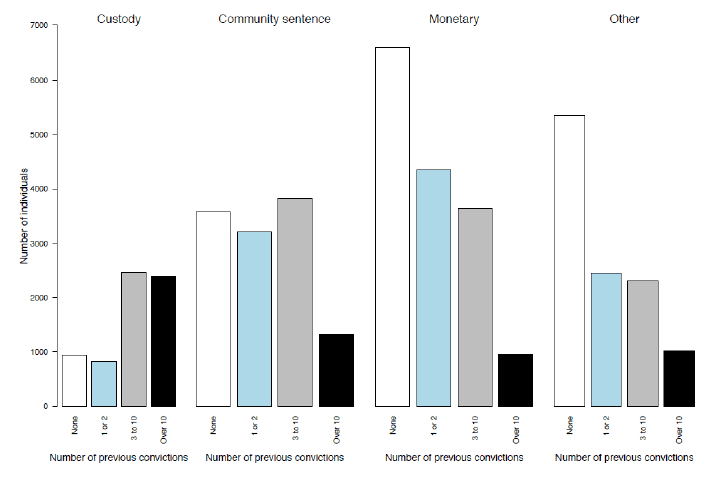Reconviction rates in Scotland: 2014-2015 offender cohort
Analysis of trends in reconviction statistics up to the latest cohort of 2014 to 2015.
This document is part of a collection
4. Number and type of previous convictions: 2006-07 to 2015-16
This section presents information on previous convictions for those offenders who were convicted on at least one occasion in 2015-16 ( Table 15 and Table 16). These two tables are compiled on a different basis to the remainder of this publication; looking at the number of individuals convicted at least once in 2015-16 and then examining their conviction history over the previous ten years. In contrast, all other tables in this publication focus on those convicted in 2014-15 and then count how many were reconvicted in the 2015-16 follow up period.
Of the 45,230 individuals convicted at least once in 2015-16 for a crime or relevant offence, 57% had at least one prior conviction in the previous ten years, whilst 13% had over 10 previous convictions ( Table 16).
As is consistent with the findings of previous Reconviction Rates in Scotland publications, sentencing is influenced by offending history as well as the circumstances of a particular case. Table 15 and Chart 12 shows that:
- The proportion of offenders given a custodial sentence increases with the number of previous convictions of an individual offender over the past ten years. Only 5.7% of first time offenders were given custodial sentences while this value increases to 20.1% of those with between 3 and 10 previous convictions and 42.0% of those with more than 10 previous convictions in the past ten years.
- A high proportion of first time offenders are given a caution/admonition (32.5%) but for offenders with more previous convictions this value decreases from 22.6% for those with one or two convictions to 18.8% for those with 3 to 10 and 17.9% for those with more than 10 previous convictions.
- The proportion of offenders given community sentences is nearly the same for first time offenders and offenders with more than 10 previous convictions (21.8% and 23.2% each respectively). Offenders with one or two and between 3 and 10 previous convictions are more likely to be given community sentences at 29.6 and 31.3% respectively.
- First time offenders and those with one or two previous convictions are most likely to be given fines (40.1% and 40.2% respectively). Offenders with more than 10 previous convictions are least likely to be given fines (16.8%).
The number of prior convictions for serious offences is strongly linked to the likelihood of getting a custodial sentence: 9.9% of those with no prior solemn convictions ( i.e. in the high or sheriff solemn court) get a custodial sentence, rising to 35.0% for those with 1 or 2 solemn convictions and 60.4% for those with 3 to 10 solemn convictions.
Over the past ten years the proportion of prolific offenders, those with more than ten previous convictions, has remained relatively constant ( Table 16). Twelve per cent of offenders in 2006-07 had over 10 previous convictions in the previous ten years and the figure has fluctuated between 12 and 14 per cent over the last decade, with 13 per cent of offenders in 2015-16 having over 10 previous convictions in the previous ten years.
Chart 12: Number of individuals convicted in 2014-15, by last disposal in 2014-15 and the number of previous convictions since 2005-06

Contact
Email: Mariken Schipper
Phone: 0300 244 4000 – Central Enquiry Unit
The Scottish Government
St Andrew's House
Regent Road
Edinburgh
EH1 3DG
There is a problem
Thanks for your feedback